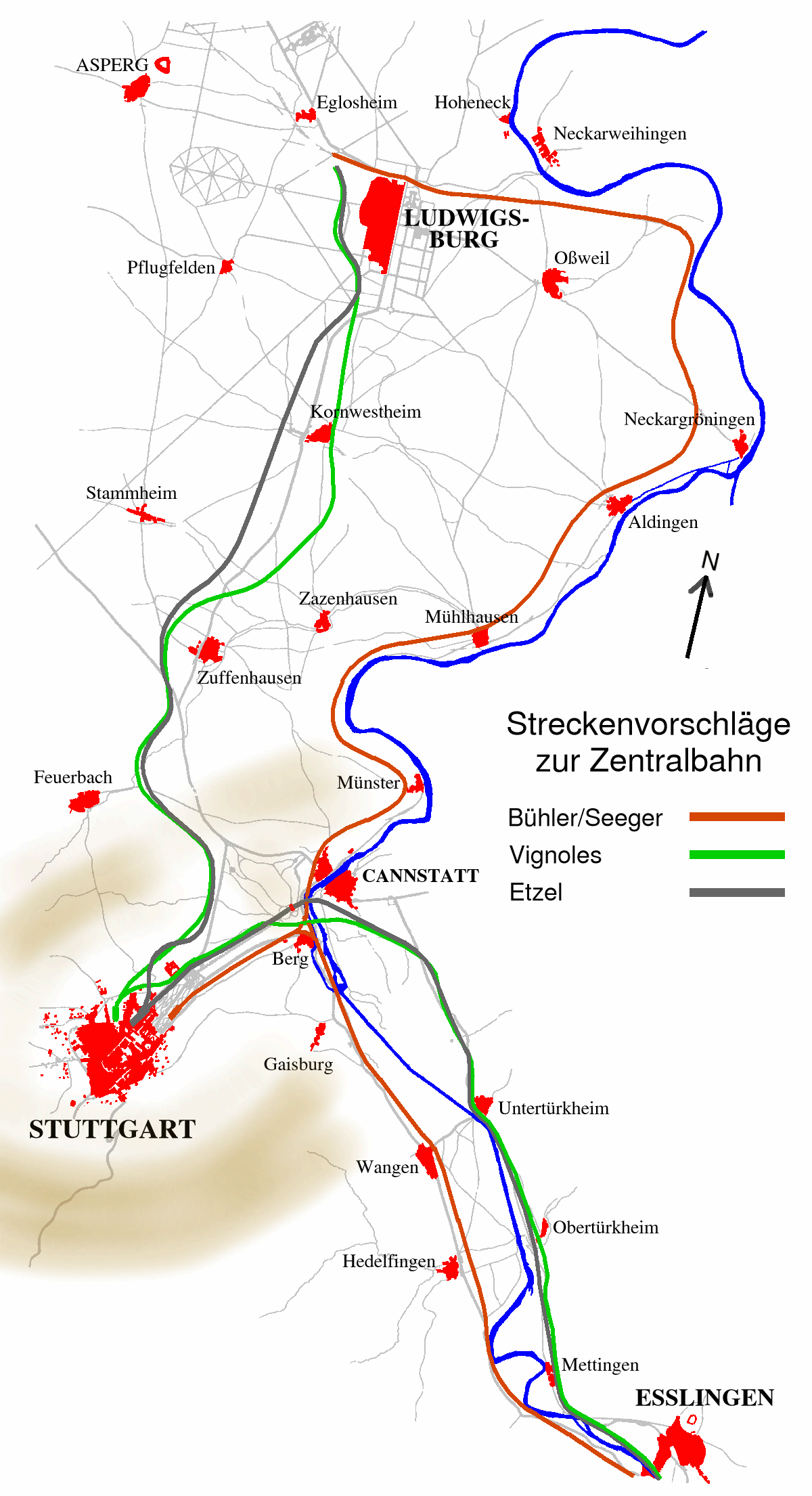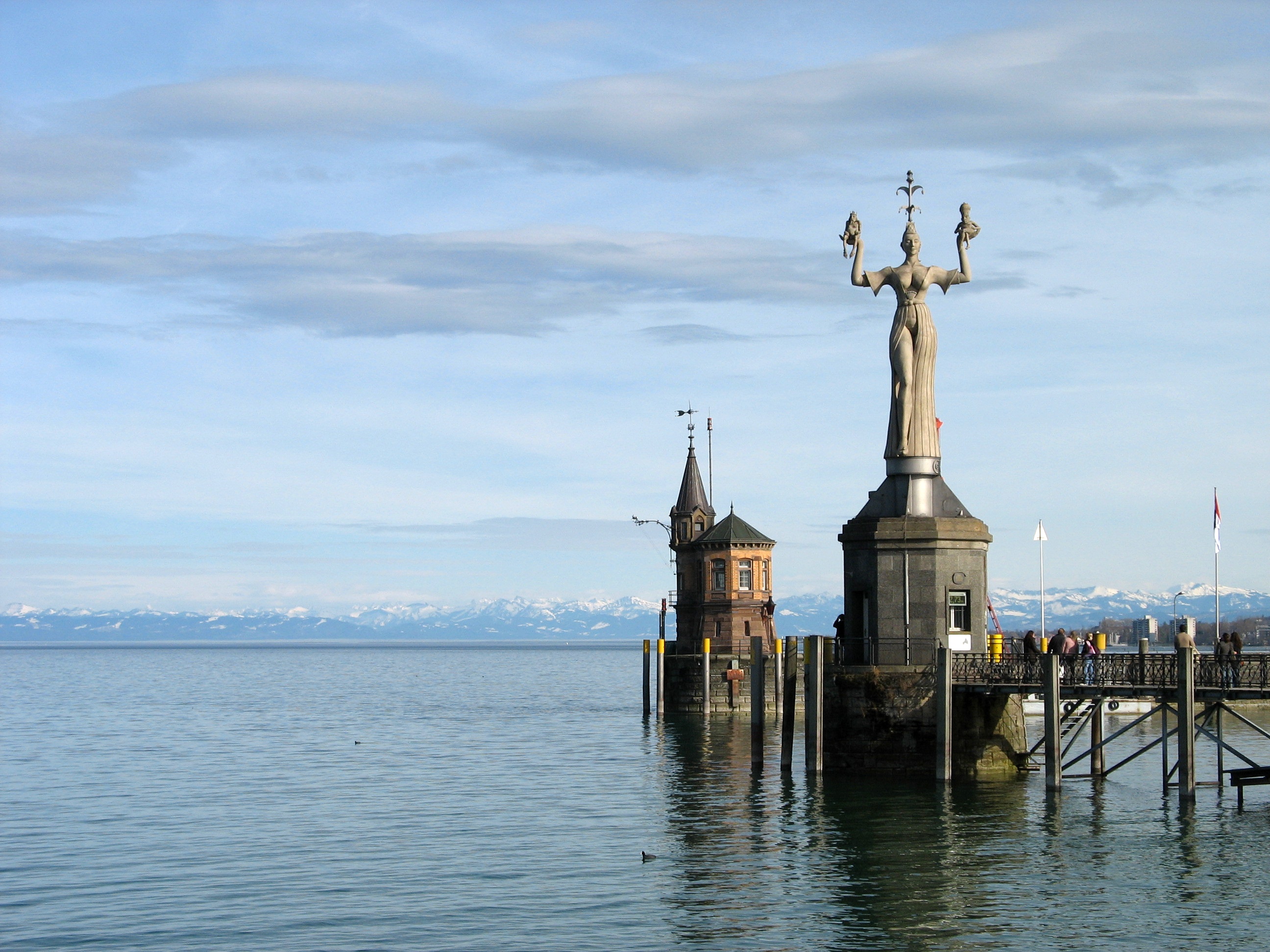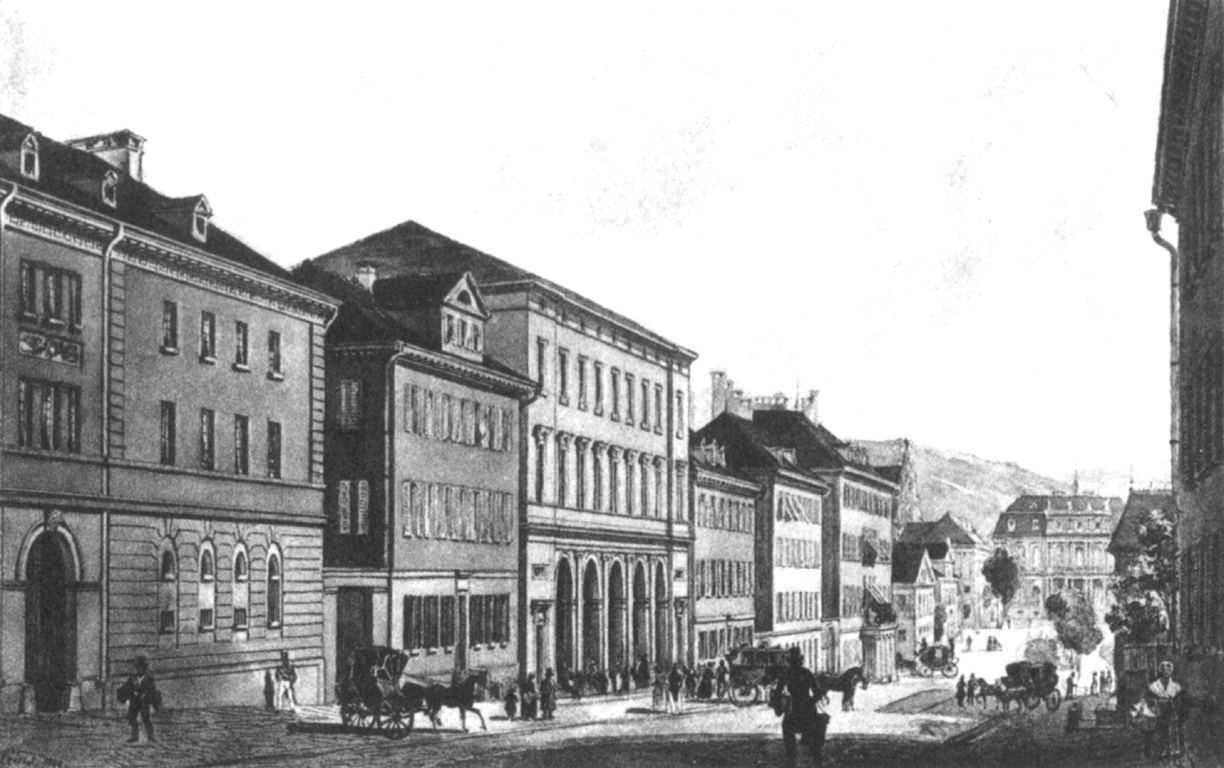|
Württemberg Central Railway
The Central Railway (german: Zentralbahn or ''Centralbahn'') was the first phase of the Württemberg railways. It was built between 1844 and 1846 by the Royal Württemberg State Railways (''Königlich Württembergischen Staats-Eisenbahnen'') and consisted of two branches, running from Stuttgart to Ludwigsburg in the north and from Stuttgart to Esslingen in the east. The term ''Zentralbahn'' did not last long, as the two branches were soon extended to Heilbronn and Ulm, and were then known as the ''Nordbahn'' ( Northern Railway) and the ''Ostbahn'' (Eastern Railway) or ''Filsbahn'' (Fils Valley Railway). The Ludwigsburg–Stuttgart–Esslingen section as a whole was still of great importance, since it continued to be the core of the network and was the busiest section of the Württemberg railways and it also served the largest metropolitan area in the country. For these reasons, it has undergone many changes and enhancements over time. Route The two branches began at Zentra ... [...More Info...] [...Related Items...] OR: [Wikipedia] [Google] [Baidu] |
Rosenstein Castle
) , alternate_names = , etymology = ''Die Rosenstein'' (german: link=no, The Rose Rock), for the rock it sits upon. , status = Complete , cancelled = , topped_out = , building_type = Palace , architectural_style = Classical , classification = , location = Rosenstein Park , address = , location_city = Stuttgart , location_country = Germany , coordinates = , altitude = , current_tenants = , namesake = Rose garden on the palace grounds , groundbreaking_date = 1824 , start_date = 1824 , topped_out_date = , completion_date = 1829 , opened_date = , inauguration_date = , relocated_date = , renovation_date = 1950–1960 1990–1992 , closing_date = , demolition_date = 1944 , cost = , ren_cost = , client = State Museum of Natural History Stut ... [...More Info...] [...Related Items...] OR: [Wikipedia] [Google] [Baidu] |
Stuttgart
Stuttgart (; Swabian: ; ) is the capital and largest city of the German state of Baden-Württemberg. It is located on the Neckar river in a fertile valley known as the ''Stuttgarter Kessel'' (Stuttgart Cauldron) and lies an hour from the Swabian Jura and the Black Forest. Stuttgart has a population of 635,911, making it the sixth largest city in Germany. 2.8 million people live in the city's administrative region and 5.3 million people in its metropolitan area, making it the fourth largest metropolitan area in Germany. The city and metropolitan area are consistently ranked among the top 20 European metropolitan areas by GDP; Mercer listed Stuttgart as 21st on its 2015 list of cities by quality of living; innovation agency 2thinknow ranked the city 24th globally out of 442 cities in its Innovation Cities Index; and the Globalization and World Cities Research Network ranked the city as a Beta-status global city in their 2020 survey. Stuttgart was one of the host cit ... [...More Info...] [...Related Items...] OR: [Wikipedia] [Google] [Baidu] |
Nesenbach
The Nesenbach is a stream in Stuttgart, the capital of Baden-Württemberg, Germany, a tributary of the Neckar The Neckar () is a river in Germany, mainly flowing through the southwestern state of Baden-Württemberg, with a short section through Hesse. The Neckar is a major right tributary of the Rhine. Rising in the Schwarzwald-Baar-Kreis near Sc .... It has its source in the city's southwestern district of Vaihingen. After 12.8 kilometres, it discharges into the Neckar in the east of Stuttgart, opposite Bad Cannstatt. Probably due to the protecting effect of its narrow vale, the development of the large city of Stuttgart was possible despite its otherwise disadvantageous topography. From 1575 to 1874, water from the Glems river was deviated through a tunnel to the Nesenbach to ensure water supply in dry seasons. References Geography of Stuttgart Rivers of Baden-Württemberg Rivers of Germany {{BadenWürttemberg-river-stub ... [...More Info...] [...Related Items...] OR: [Wikipedia] [Google] [Baidu] |
Konstanz
Konstanz (, , locally: ; also written as Constance in English) is a university city with approximately 83,000 inhabitants located at the western end of Lake Constance in the south of Germany. The city houses the University of Konstanz and was the residence of the Roman Catholic Diocese of Konstanz for more than 1,200 years. Location The city is located in the state of Baden-Württemberg and situated at the banks of Lake Constance (''Bodensee'' in German). The river Rhine, which starts in the Swiss Alps, passes through Lake Constance and leaves it, considerably larger, by flowing under a bridge connecting the two parts of the city. North of the river lies the larger part of the city with residential areas, industrial estates, and the University of Konstanz; while south of the river is the old town, which houses the administrative centre and shopping facilities in addition to the ''Hochschule'' or the ''University of Applied Sciences''. Car ferries provide access across Lake C ... [...More Info...] [...Related Items...] OR: [Wikipedia] [Google] [Baidu] |
Bruchsal
Bruchsal (; orig. Bruohselle, Bruaselle, historically known in English as Bruxhall; South Franconian German, South Franconian: ''Brusel'') is a city at the western edge of the Kraichgau, approximately 20 km northeast of Karlsruhe in the state of Baden-Württemberg, Germany. It is located on Bertha Benz Memorial Route. Bruchsal is the largest city in the district of Karlsruhe (district), Karlsruhe and is known for being Europe's largest asparagus producer and one of the economic centers of Karlsruhe (region), the region of Karlsruhe. The Bruchsal area also includes the cities and towns of Bad Schönborn, Forst (Baden), Forst, Hambrücken, Karlsdorf-Neuthard, Kraichtal, Kronau (Baden), Kronau, Oberhausen-Rheinhausen, Östringen, Philippsburg, Ubstadt-Weiher and Waghäusel. Until 1972 Bruchsal was the seat of the district of Bruchsal (district), Bruchsal, which was merged into the district of Karlsruhe (district), Karlsruhe as a result of the district reform, effective January 1 ... [...More Info...] [...Related Items...] OR: [Wikipedia] [Google] [Baidu] |
Stuttgart North Station
Stuttgart Nord station (german: Nordbahnhof) is in the German state of Baden-Württemberg. It consists of a passenger railway station on the Stuttgart S-Bahn and a goods yard. History Owing to the increasing volume of traffic, the Royal Württemberg State Railways (''Königlich Württembergische Staats-Eisenbahnen'') required further locomotives. In 1891, the railways acquired land for a new yard in the district of Prag at the junction of the Gäu and the Northern Railways (''Frankenbahn'') with a locomotive depot with 59 locomotive stalls and a freight yard. Two years later, in 1893, construction began. The aim was to relieve the old Stuttgart Central Station. Tracks were also laid from Feuerbach for freight trains running towards the Gäu Railway. In April 1894, the railway depot was inaugurated. On 1 November 1895, operations started at the Prag goods yard (''Prag-Güterbahnhof''). It also had a military loading ramp and a loading dock for the discharge of sewage. The Prag ... [...More Info...] [...Related Items...] OR: [Wikipedia] [Google] [Baidu] |
Rosenstein Park
The Rosenstein Park (german: Rosensteinpark) in Stuttgart is the largest English garden in southwest Germany. Its creation took place from 1824 to 1840 on the orders of King William I of Württemberg after plans of his gardener Johann Bosch on the former ''Kahlenstein'' area. From 1817 to 1818 King William I had purchased all land on the Kahlenstein from the citizens of Cannstatt. In the middle of the park the '' Rosenstein Palace'' was built from 1822 to 1830. The ''Wilhelma'' zoo and the ''State Museum of Natural History Stuttgart'' are also located in the park. The ''Löwentor'' (Lion's Gate) at the upper park entrance was built by Giovanni Salucci. The ''Rosenstein Tunnel'' is a railway tunnel beneath the park. Today the park is owned by the State of Baden-Württemberg and preserved as a historical monument. [...More Info...] [...Related Items...] OR: [Wikipedia] [Google] [Baidu] |
Feuerbach (Neckar)
Feuerbach (in its upper course: ''Metzgerbach'') is a river of Baden-Württemberg, Germany. It passes northwest of Stuttgart, and flows into the Neckar in the ''Stadtteil'' Stuttgart-Mühlhausen. See also *List of rivers of Baden-Württemberg A list of rivers of Baden-Württemberg, Germany: A * Aal * Aalbach *Aalenbach * Ablach * Ach * Acher *Adelbach * Aich * Aid * Aischbach, tributary of the Kinzig * Aischbach, tributary of the Körsch * Aitrach, tributary of the Danube * Aitrach, ... References Rivers of Baden-Württemberg Rivers of Germany {{BadenWürttemberg-river-stub ... [...More Info...] [...Related Items...] OR: [Wikipedia] [Google] [Baidu] |
Stuttgart Central Station
Stuttgart Hauptbahnhof (; en, Stuttgart central station) is the primary railway station in the city of Stuttgart, the state capital of Baden-Württemberg, in southwestern Germany. It is the largest regional and long-distance railway station in Stuttgart, the main node of the Stuttgart S-Bahn network, and, together with the station at Charlottenplatz, it is the main node of the Stuttgart Stadtbahn. Located at the northeastern end of the ''Königstraße'', the main pedestrian zone of the city centre, the main line station is a terminus, whilst the subterranean S-Bahn and Stadtbahn stations are through-stations. The station is well known for its 12-storey tower with a large, rotating and illuminated Mercedes-Benz star insignia on top; the tower and station building are city landmarks. Plans for the controversial Stuttgart 21 project to convert the main line terminus station into an underground through station include the demolition of the side wings of the building, together w ... [...More Info...] [...Related Items...] OR: [Wikipedia] [Google] [Baidu] |
Fils Valley Railway
The Fils Valley Railway (german: Filstalbahn, historically ''Filsbahn'' or ''Württembergische Ostbahn''—Württemberg Eastern Railway) designates the Württemberg line from Stuttgart via Göppingen to Ulm. It runs from Plochingen to Geislingen an der Steige through the Fils Valley. History Construction The Fils Valley Railway was built as part of the first railway line in Württemberg connecting the navigable Neckar in Heilbronn via Stuttgart with the navigable Danube at Ulm, with a further connection from Ulm to Lake Constance. The Stuttgart-Esslingen section of the line was built as part of the Central Railway (''Zentralbahn'') between 1844 and 1846. The line was completed between Cannstatt and Esslingen on 22 October 1845 and the Rosenstein Tunnel was completed on 4 July 1846, allowing the first train to run into Stuttgart station on 26 September 1846. It was extended to Plochingen in December 1846 and on 28 June 1850, the first train rolled over the new ... [...More Info...] [...Related Items...] OR: [Wikipedia] [Google] [Baidu] |
Franconia Railway
The Franconia Railway (german: Frankenbahn) is a railway line in the north of the German state of Baden-Württemberg and the Bavarian province of Lower Franconia that links Stuttgart and Würzburg. Its name comes from the fact that the majority of the line runs through Franconia. The first section of the line was opened in 1848 and is one of the oldest lines in Germany. The main line is now electrified and has been almost entirely upgraded to double-tracks. Name The name ''Frankenbahn'' is not a historical term for the Stuttgart–Würzburg line, but was adopted in 1996 following the regionalisation of operations. Other historical names for different sections of the line included the Central Railway (''Centralbahn''), the first railway in Württemberg, running from Esslingen to Stuttgart and Ludwigsburg. The part of this route east of Stuttgart is now considered to be part of the Fils Valley Railway (''Filstalbahn''). It was later called the Northern Railway (''Nordbahn''), ... [...More Info...] [...Related Items...] OR: [Wikipedia] [Google] [Baidu] |








